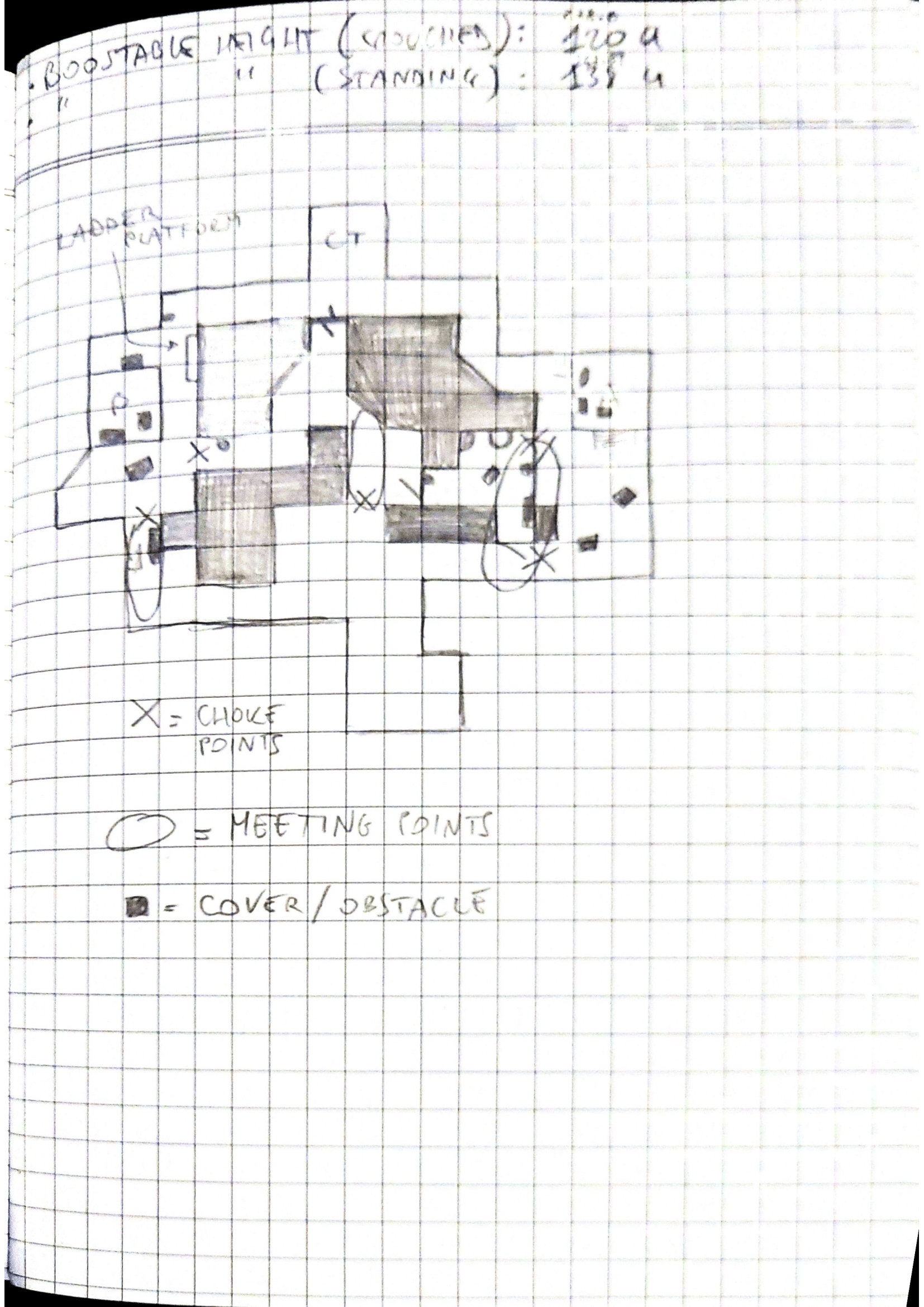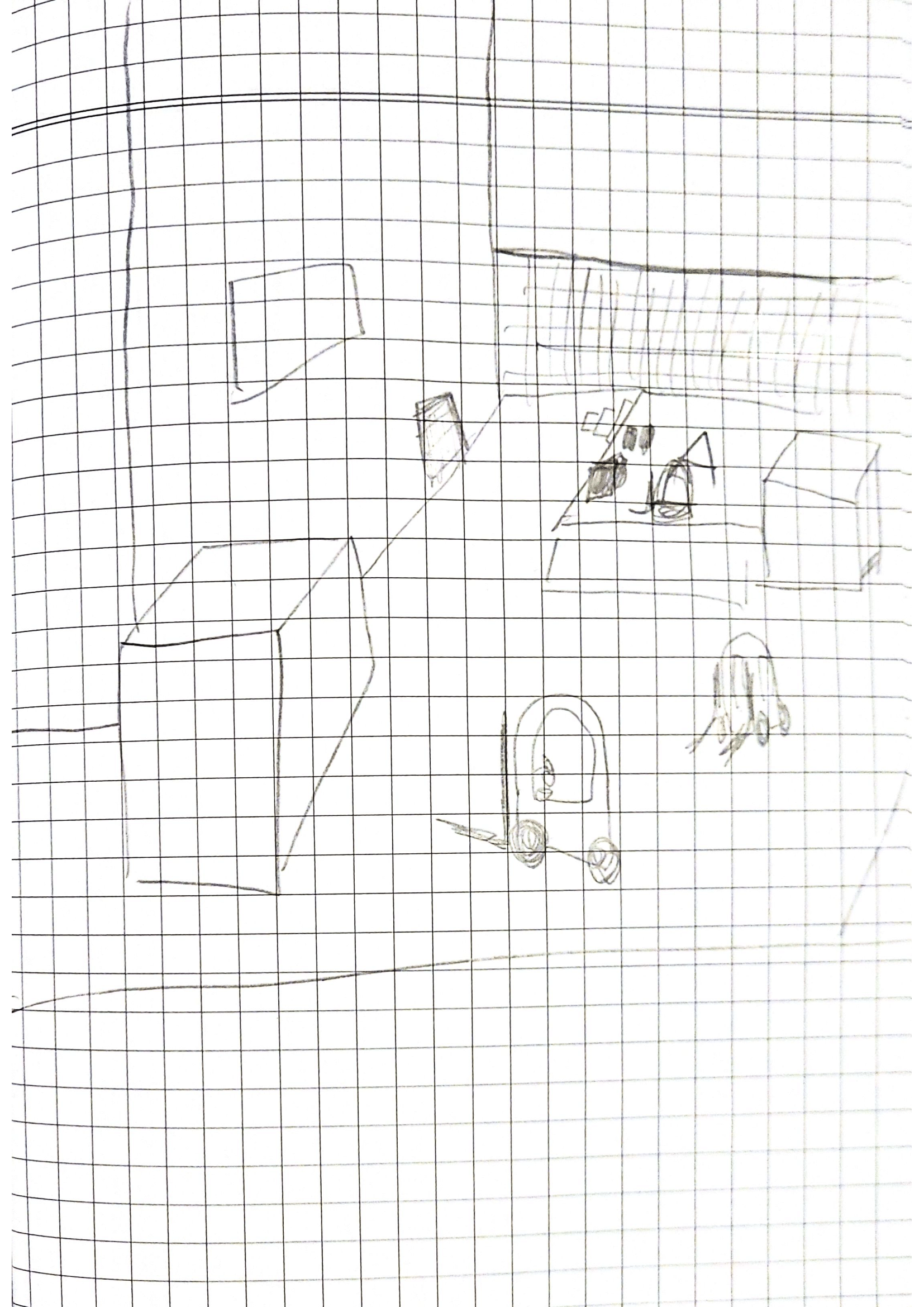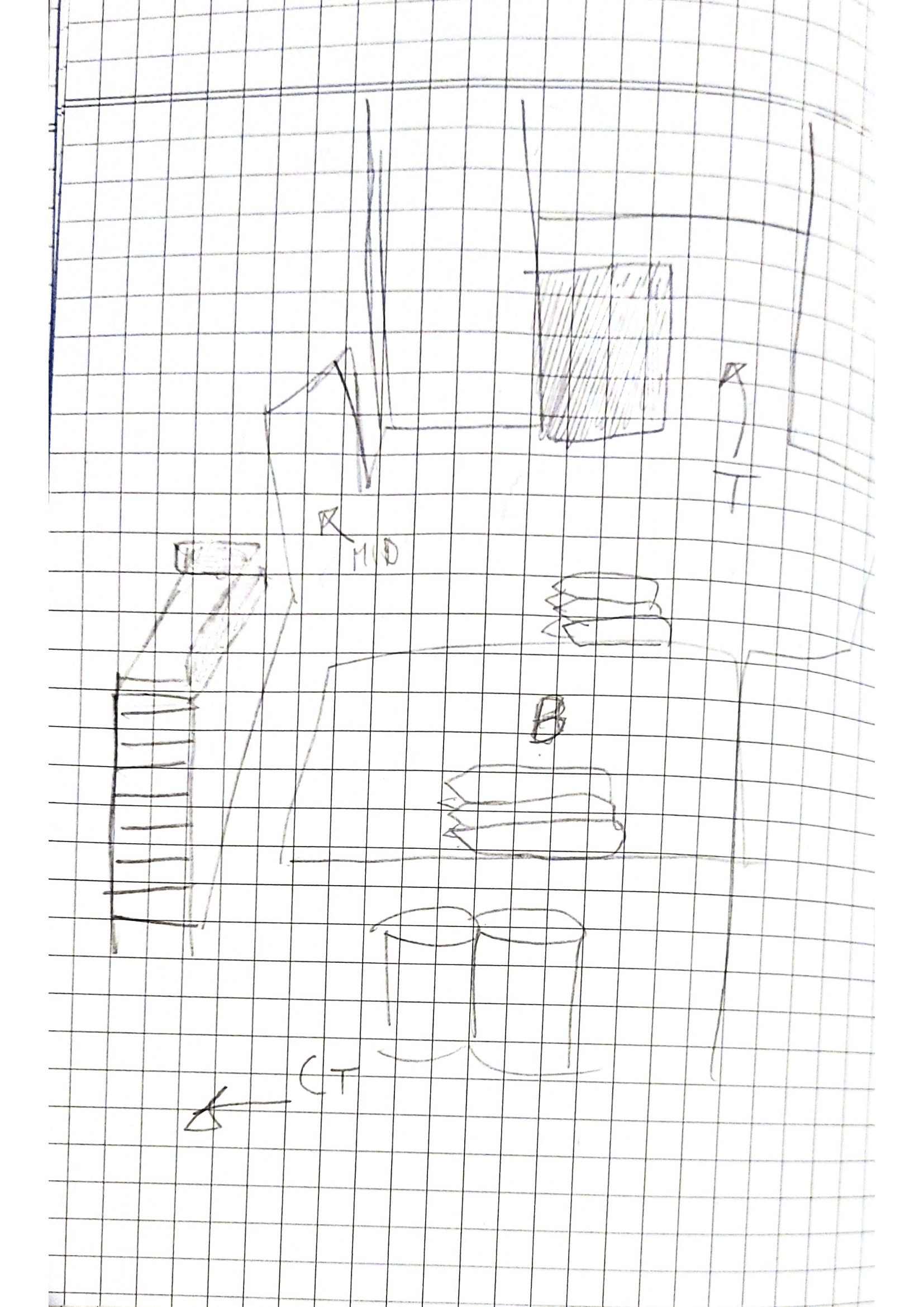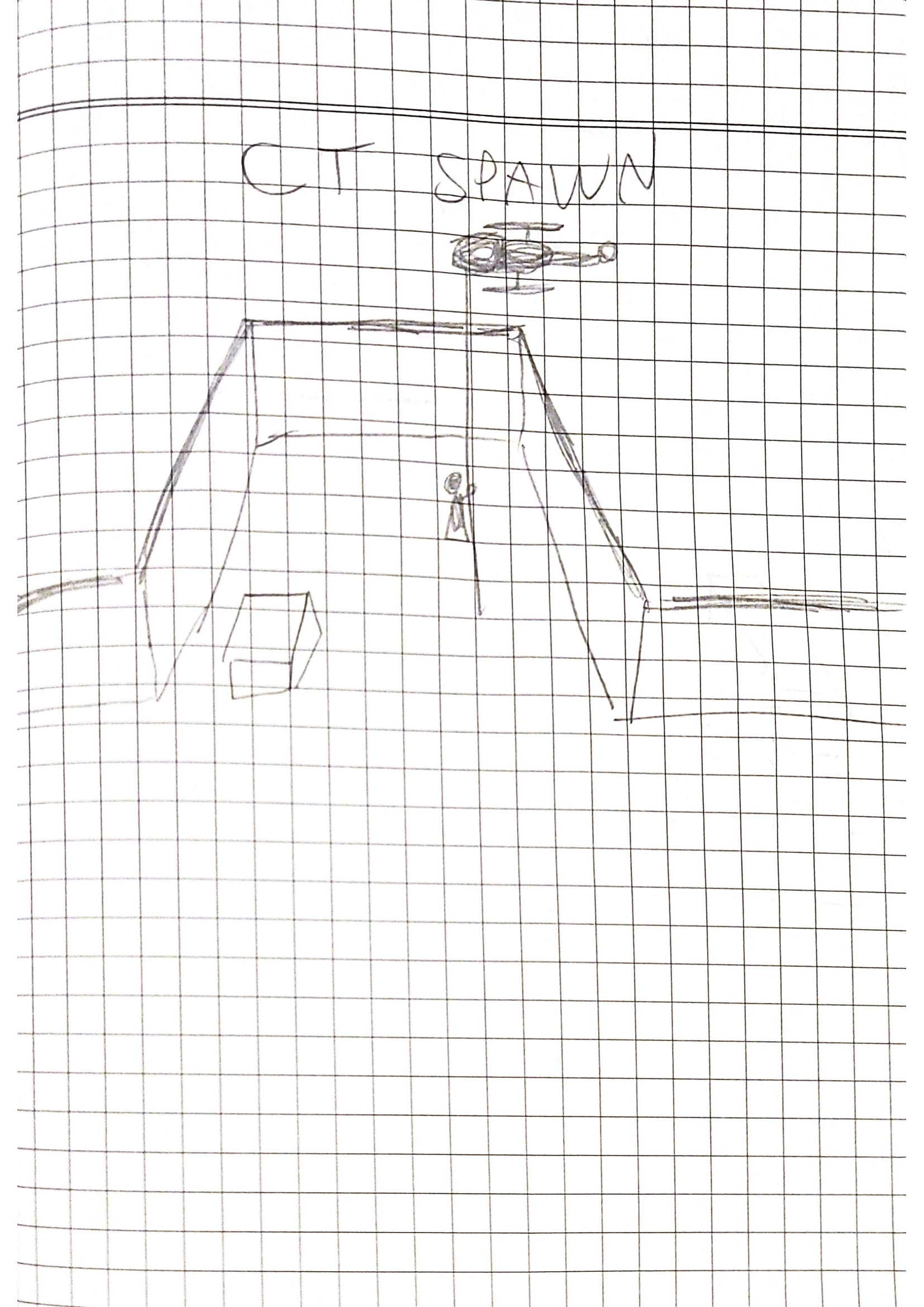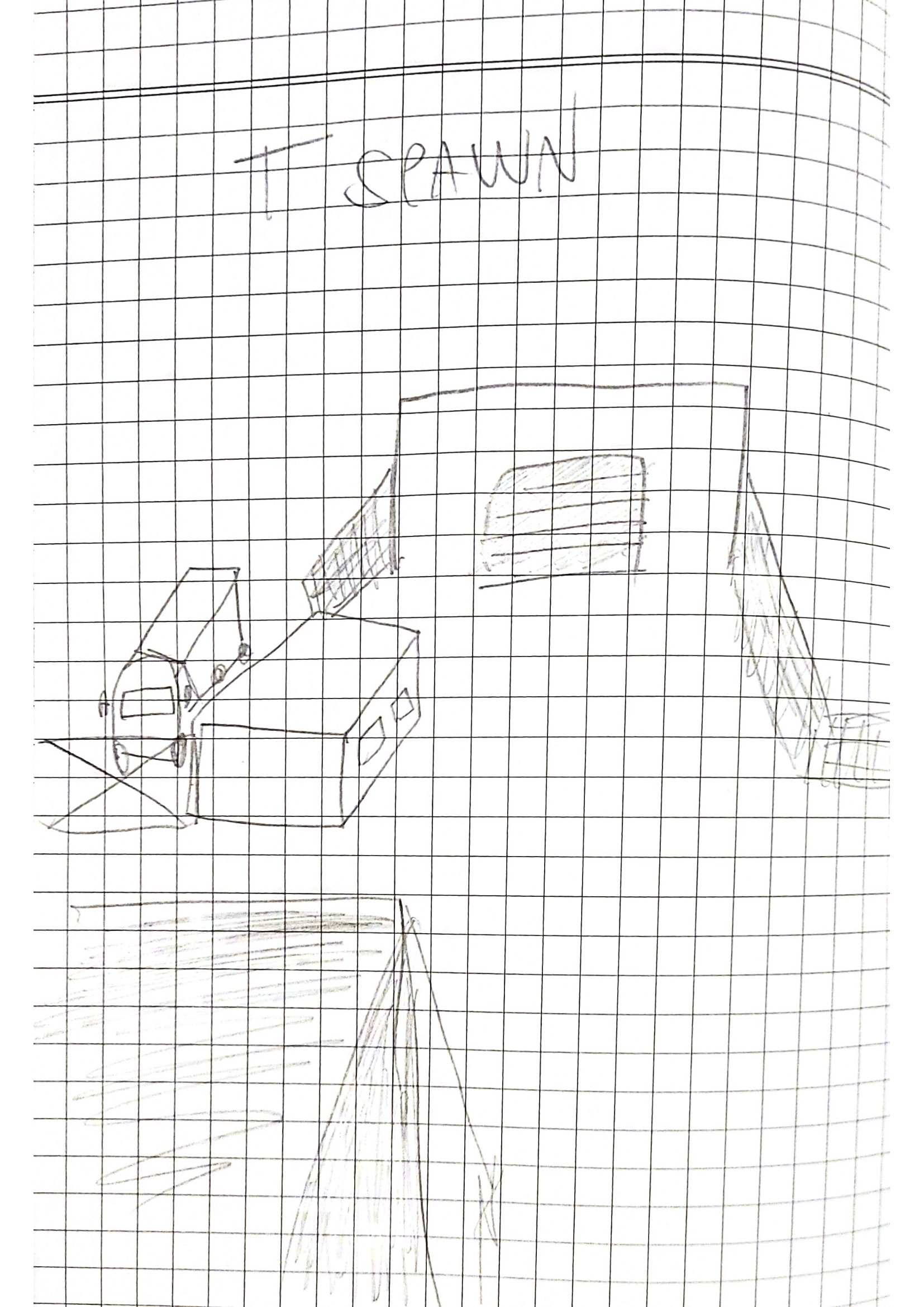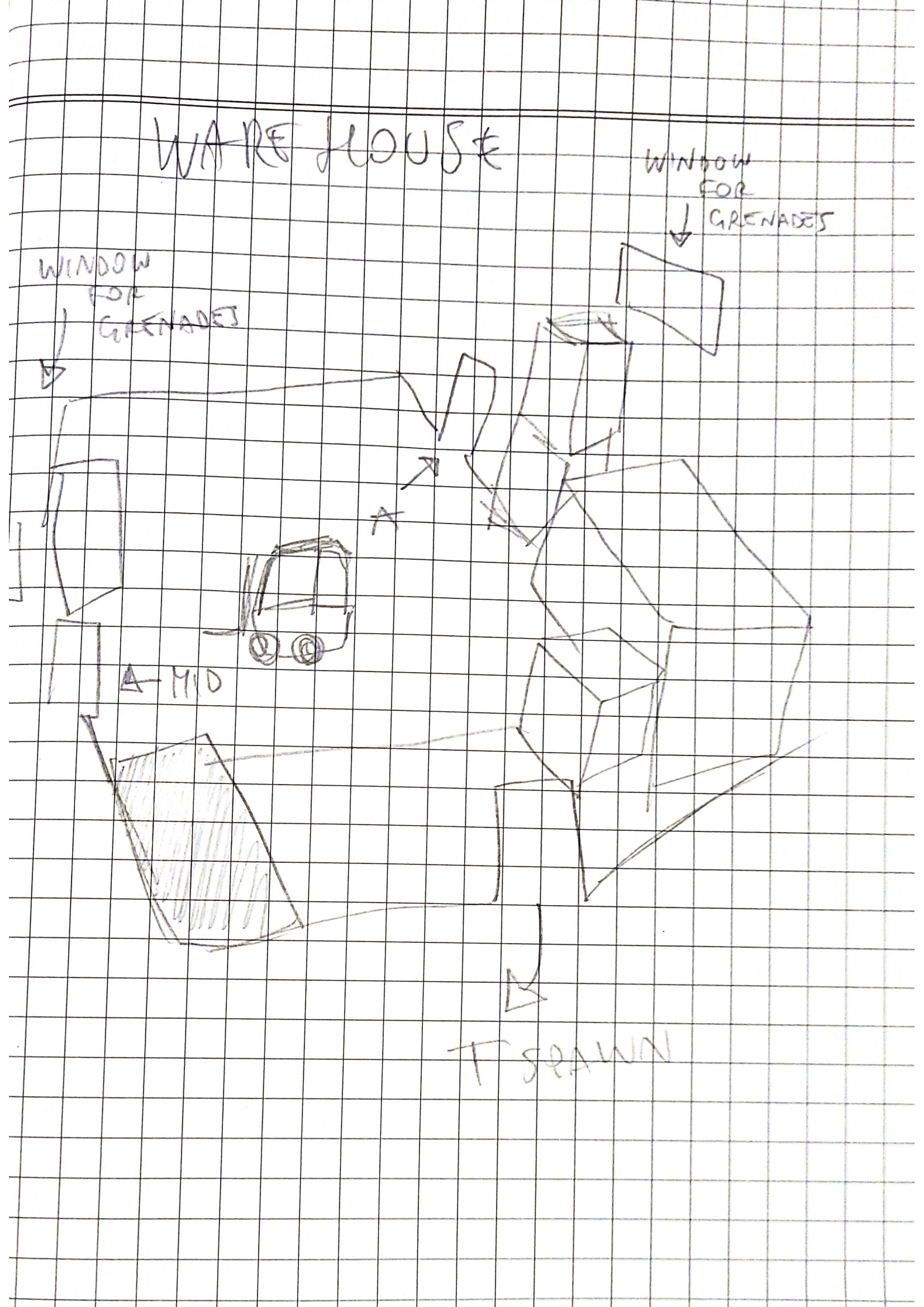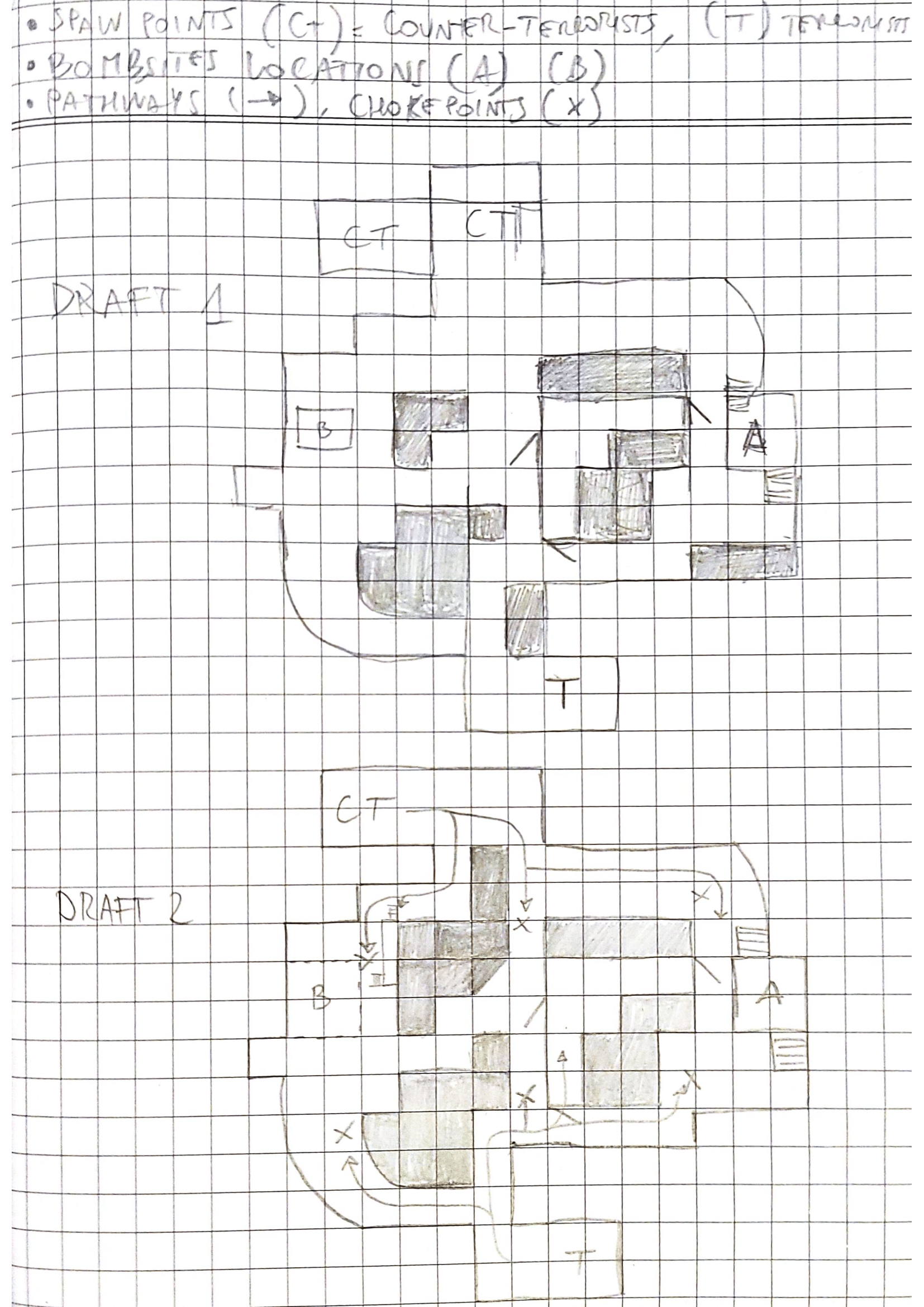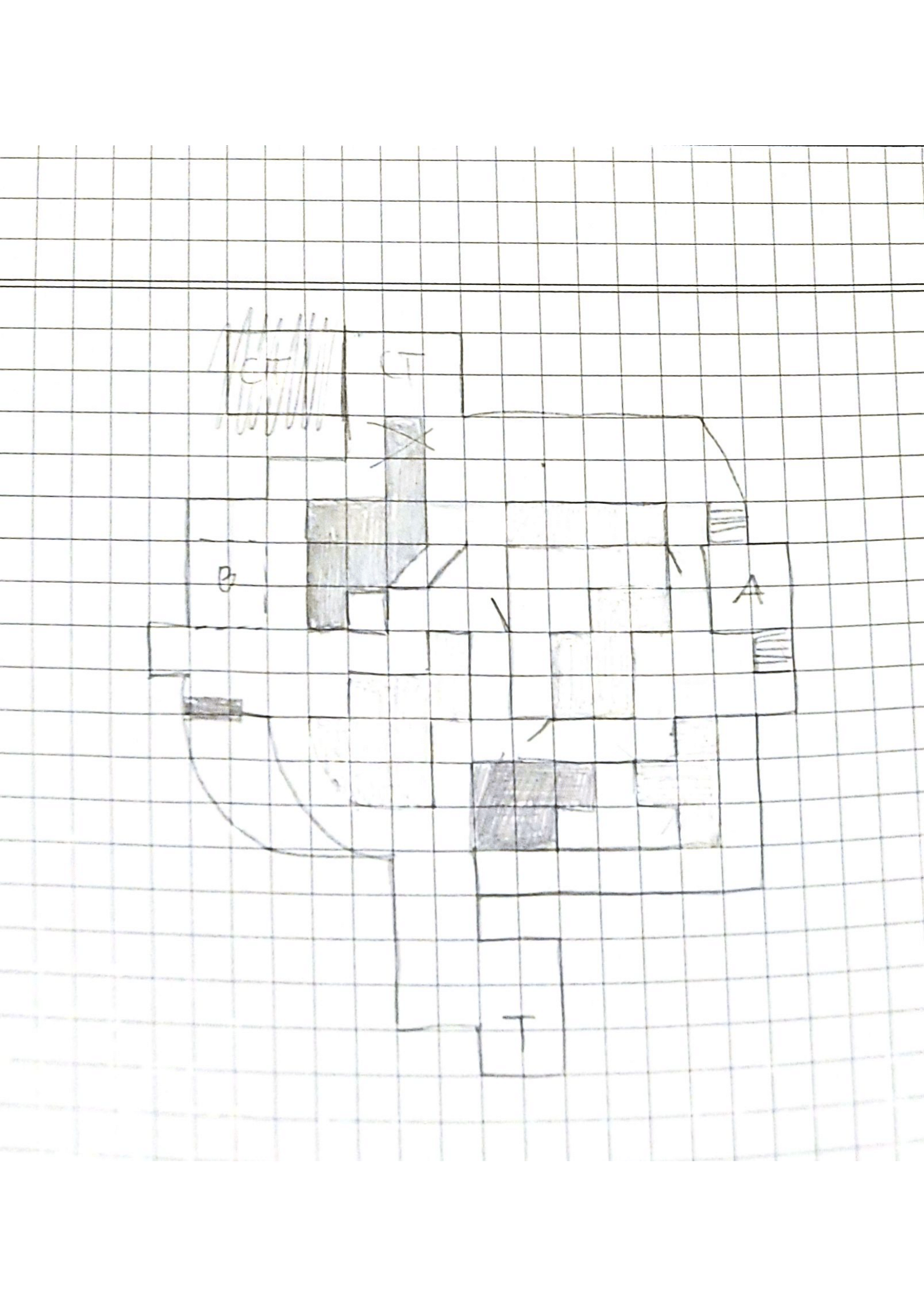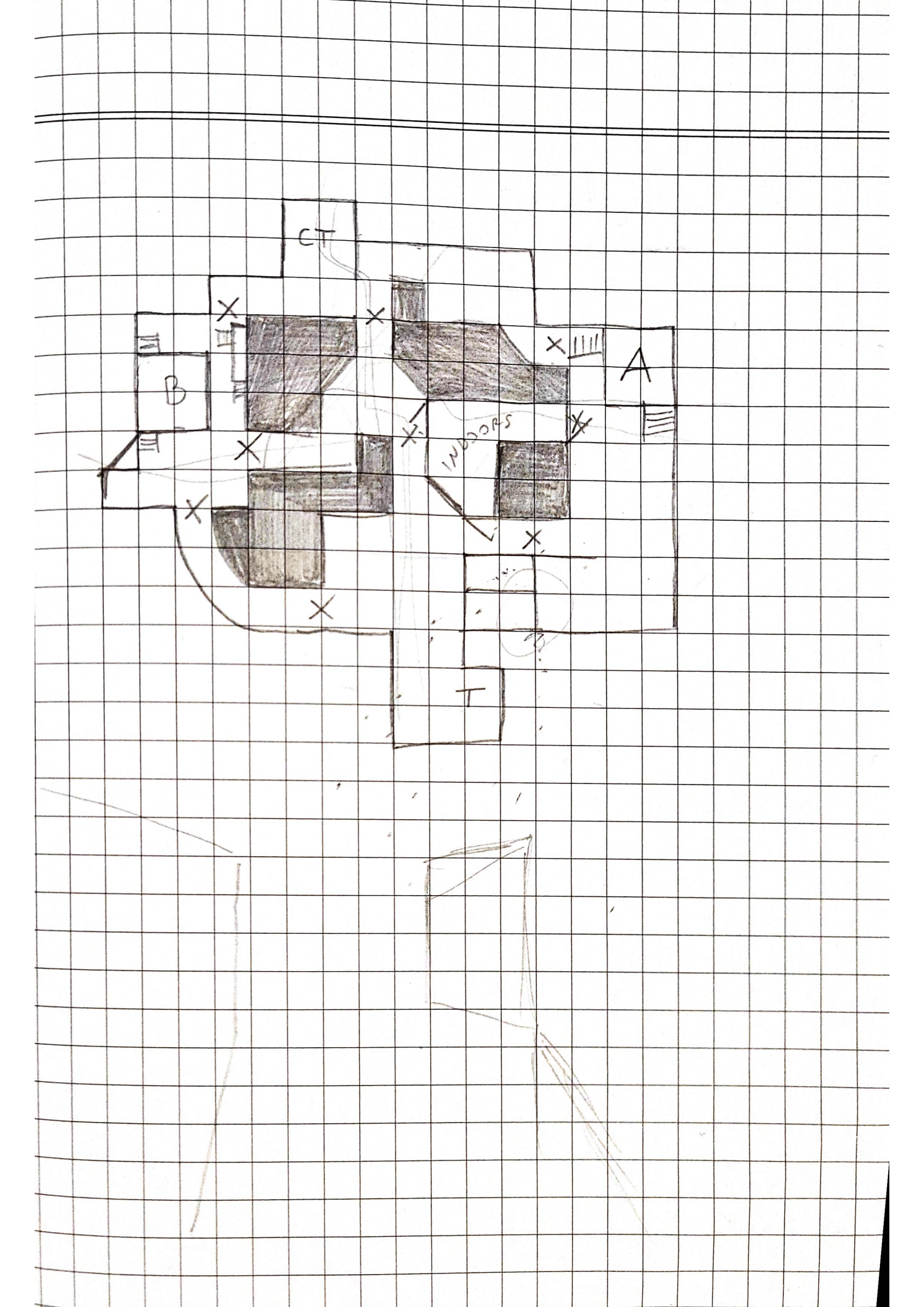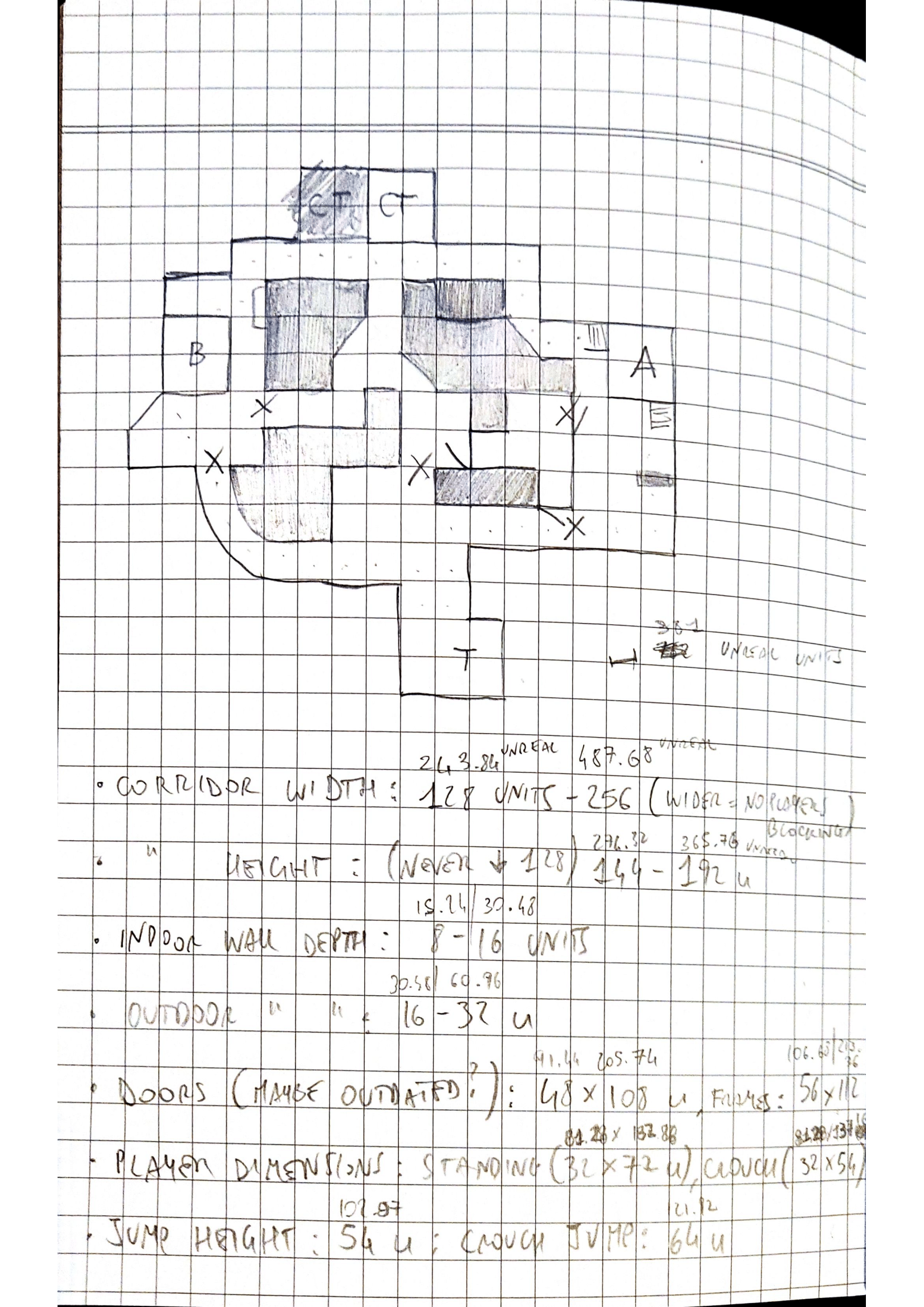CS2/Valorant Project
January 2022 - May 2022
Individual University project
My roles: Level designer
Inspirations: Counter Strike 2, Valorant
Genres: First Person Shooter
Platforms: PC
Engine: Unreal Engine 4.26.2
Tools: Unreal Engine 4, GitHub, Microsoft Office tools, Google Workspace
Team size: Solo
Pre-production

One of the first things I did was look for GDC talks on Counter-Strike. I came across a video called Community Level Design for Competitive Counter-Strike:GO. Sal Garozzo and Shawn Snelling talk about the importance of having a limited number of choke points (a.k.a. areas in which opposing teams can clash). Attackers (or T’s/Terrorists) will normally have someone watch one bomb site, two will attack the other and the final two will stay in “mid”, the middle area that most zones are connected to. Defenders (or CT’s/Counter-Terrorists) will also play in a similar fashion and will “rotate” (move defenders into an objective that will likely be pushed or attacked) when they realize that the site they’re defending is not being targeted. Therefore, it’s important to limit the areas of danger. On bombsites, there are a limited number of spots where players can normally hide. Garozzo explains that in A site on Cache there are only 5, which may seem like too few, but the lines of sight cover the entire area. In the talk, they also explain Stacking and Boosting, as well as Wall-banging as mechanics to turn the tide around.

Another incredibly useful resource that heavily influenced the metrics and techniques used to make the blockout was this post on Steam’s forums made by Explodus called The dos and don’ts of Counter-Strike level design. It broke down many elements of what a level designer should include and consider in a map, between layout, navigation, timings, risk and reward, sight lines, verticality, cover etc.
This guide was perfect for me as it helped me integrate the findings of my research with practical advice.
I then began researching how other maps are layed out and broke them down into their "four square layout" (where available, unlike Haven from Valorant) and highlighting meeting points and choke points.
Blockout

I used Supergrid for the creation of the blockout. Translating the level from paper to engine was very simple thanks to the notes I took about the scale of the map and its elements.
The level went through several iterations in this phase, due to playtesting. The majority of people I asked for playtesting were either familiar with or played Counter-Strike regularly, and I gained a lot of insight thanks to their advice.
Initially the Attackers/Terrorists would arrive roughly at the same time as the Defenders/Counter-terrorists in A Site, so I made sure to create a longer tunnel between CT spawn and A-site.


Following the notes I took from the GDC talk, I created an instance where players could collaborate for stacking and boosting. This allows players to stack and get one player on top of some containers overlooking A site, coming on from CT.

The warehouse was created to bridge mid and A site, giving either team the option to rotate faster from A to B. I also added windows overlooking both A site and Mid, that would break and allow grenades to pass through, giving a potential tactical advantage for players who wish to push in.

B Site has the option for an Attacker/Terrorist to use a ladder and take advantage of verticality to look over the bomb site. This particular spot is high risk and high reward, however. This is because the platform only covers someone who's crouching and its handrail is made of wood. The material choice is intentional, as all the surfaces in the level that are made of oak (light coloured) wood are penetrable by bullets, allowing players to "wallbang".

Finally, B site is the other bomb site in which players can clash for victory. This site as mentioned before allows T/Attackers to use verticality for advantage at a high cost.
This site is connected faster into mid by a small corridor that serves as a choke point.
Scripting

For this project I did a couple of things in Blueprints.
The first thing I added, was the ability to crouch. Incidentally, this allowed for crouch-jumping, a mechanic in Valve games that allows the player to reach farther and higher than a regular jump.
In this Blueprint it is shown that by pressing the key to crouch (left control), both the camera and the capsule component around the player character will lower themselves.


The ladder was slightly more complex. I created it by combining basic static meshes into one and created a Blueprint actor.
I had to make sure that when the player character collides with the collision box (red box in the picture, next to the ladder), a Boolean activates. Then I had to tell to the FirstPersonCharacter BP that if the player is colliding with the ladder, to activate flying mode but it would only move the character up or down. Then if the player is no longer in the box, the movement mode goes back to walking.
Final thoughts
There are several things I can say worked out quite well for this project. I was able to do sufficient research, particularly on CS:GO and Valorant maps, I learned new techniques in level design as well as things to look out for while creating a map for Counter-Strike and things to include. Thanks to people who playtested my level, I was able to iterate effectively, and I saw my design evolve and form into something that I could make in the Source Engine for people to play. The areas are unique and easily recognizable between each other.
Some things did not work as well as I would have hoped. Firstly, I was meant to do more research, which unfortunately had to be cut down due to time restraints. I was hoping I could read some books to expand my knowledge further, but I was unable to do that. I was also hoping I could create meshes in Blender to populate my level. Thankfully, the concept of the environment was simple enough that blocky items and certain objects were easy to create with BSP geometry and SuperGrid. I know I have enough skill to create meshes in Blender, I simply did not have the time to do so. Finally, I hoped I would have been able to make a door in Blueprint that I could open, but I was unable to get one working, so I scrapped it.
Screenshots







